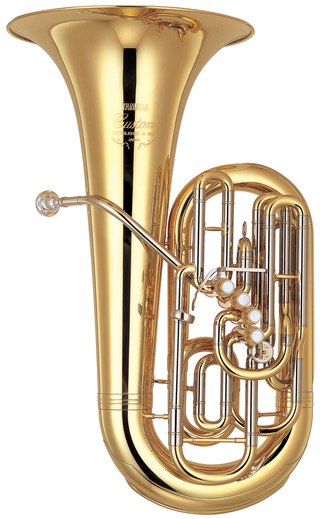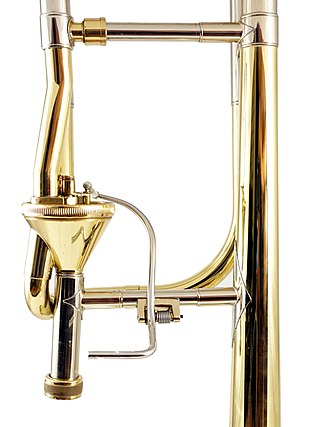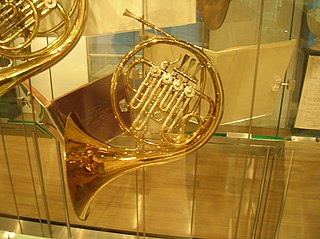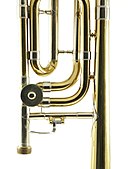
A brass instrument is a musical instrument that produces sound by sympathetic vibration of air in a tubular resonator in sympathy with the vibration of the player's lips. Brass instruments are also called labrosones or labrophones, from Latin and Greek elements meaning 'lip' and 'sound'.

The cornet is a brass instrument similar to the trumpet but distinguished from it by its conical bore, more compact shape, and mellower tone quality. The most common cornet is a transposing instrument in B♭. There is also a soprano cornet in E♭ and cornets in A and C. All are unrelated to the Renaissance and early Baroque cornett.

The euphonium is a medium-sized, 3 or 4-valve, often compensating, conical-bore, tenor-voiced brass instrument that derives its name from the Ancient Greek word εὔφωνος euphōnos, meaning "well-sounding" or "sweet-voiced". The euphonium is a valved instrument. Nearly all current models have piston valves, though some models with rotary valves do exist.

The French horn is a brass instrument made of tubing wrapped into a coil with a flared bell. The double horn in F/B♭ is the horn most often used by players in professional orchestras and bands, although the descant and triple horn have become increasingly popular. A musician who plays a horn is known as a horn player or hornist.

The trombone is a musical instrument in the brass family. As with all brass instruments, sound is produced when the player's vibrating lips cause the air column inside the instrument to vibrate. Nearly all trombones use a telescoping slide mechanism to alter the pitch instead of the valves used by other brass instruments. The valve trombone is an exception, using three valves similar to those on a trumpet, and the superbone has valves and a slide.

The trumpet is a brass instrument commonly used in classical and jazz ensembles. The trumpet group ranges from the piccolo trumpet—with the highest register in the brass family—to the bass trumpet, pitched one octave below the standard B♭ or C trumpet.

The tuba is the largest and lowest-pitched musical instrument in the brass family. As with all brass instruments, the sound is produced by lip vibration – a buzz – into a mouthpiece. It first appeared in the mid-19th century, making it one of the newer instruments in the modern orchestra and concert band, and largely replaced the ophicleide. Tuba is Latin for "trumpet".

The bass trumpet is a type of low trumpet which was first developed during the 1820s in Germany. It is usually pitched in 8' C or 9' B♭ today, but is sometimes built in E♭ and is treated as a transposing instrument sounding either an octave, a sixth or a ninth lower than written, depending on the pitch of the instrument. Having valves and the same tubing length, the bass trumpet is quite similar to the valve trombone, although the bass trumpet has a harder, more metallic tone. Certain modern manufacturers that sell 'valve trombones' and 'bass trumpets' employ the same tubing, valves, and bell in different combinations; in these circumstances, the bass trumpet is nearly similar to the valve trombone.

The mellophone is a brass instrument used in marching bands and drum and bugle corps in place of French horns. It is a middle-voiced instrument, typically pitched in the key of F, though models in E♭, D, C, and G have also historically existed. It has a conical bore, like that of the euphonium and flugelhorn. It can also be used to play French horn parts in concert bands and orchestras.

A piston valve is a device used to control the motion of a fluid or gas along a tube or pipe by means of the linear motion of a piston within a chamber or cylinder.

A rotary valve is a type of valve in which the rotation of a passage or passages in a transverse plug regulates the flow of liquid or gas through the attached pipes. The common stopcock is the simplest form of rotary valve. Rotary valves have been applied in numerous applications, including:

The axial flow valve, or Thayer valve, is a brass instrument valve design patented in 1978 by Orla Ed Thayer. Designed with assistance from Zigmant Kanstul, it was originally intended to replace the traditional rotary valve on the French horn, but instead revolutionized the design of trombone valve attachments. Combined with open-wrap tubing, it eliminates the impedance caused by tight tubing bends, improving the airflow through the instrument and the open "feel" perceived by the player.

A crook, also sometimes called a shank, is an exchangeable segment of tubing in a natural horn which is used to change the length of the pipe, altering the fundamental pitch and harmonic series which the instrument can sound, and thus the key in which it plays.

Marching brass instruments are brass instruments specially designed to be played while moving. Most instruments do not have a marching version - only the following have marching versions:
The Vienna horn is a type of musical horn used primarily in Vienna, Austria, for playing orchestral or classical music. It is used throughout Vienna, including the Vienna Philharmonic and Wiener Staatsoper.
Heinrich David Stölzel was a German horn player who developed some of the first valves for brass instruments. He developed the first valve for a brass musical instrument, the Stölzel valve, in 1818, and went on to develop various other designs, some jointly with other inventor musicians.

The Hagmann Free-Flow Valve is a trademarked brass instrument valve design developed by Swiss musician and instrument technician René Hagmann, first introduced for trombone F attachments in 1990. His intention was to address some of the geometrical limitations of the regular rotary valve, as well as the reliability and maintenance issues of the popular Thayer axial flow valve that arise from its relatively complex design.

A horn is any of a family of musical instruments made of a tube, usually made of metal and often curved in various ways, with one narrow end into which the musician blows, and a wide end from which sound emerges. In horns, unlike some other brass instruments such as the trumpet, the bore gradually increases in width through most of its length—that is to say, it is conical rather than cylindrical. In jazz and popular-music contexts, the word may be used loosely to refer to any wind instrument, and a section of brass or woodwind instruments, or a mixture of the two, is called a horn section in these contexts.

The German horn is a brass instrument made of tubing wrapped into a coil with a flared bell, and in bands and orchestras is the most widely used of three types of horn, the other two being the French horn and the Vienna horn. Its use among professional players has become so universal that it is only in France and Vienna that any other kind of horn is used today. A musician who plays the German horn is called a horn player. The word "German" is used only to distinguish this instrument from the now-rare French and Viennese instruments. Although the expression "French horn" is still used colloquially in English for any orchestral horn, since the 1930s professional musicians and scholars have generally avoided this term in favour of just "horn". Vienna horns today are played only in Vienna, and are made only by Austrian firms. German horns, by contrast, are not all made by German manufacturers, nor are all French-style instruments made in France.
Étienne-François Périnet was a French instrument maker, best known for his development of an early piston valve system for brass instruments.

























